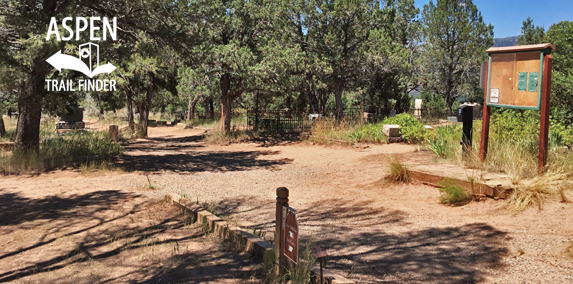Connects: Pioneer Cemetery Trail, Doc Holliday’s Grave, Kid Curry’s Grave

Linwood Cemetery where Doc Holliday’s memorial is located
Glenwood Springs, CO – Cemetery
Linwood Cemetery, also known as Pioneer Cemetery and Glenwood Cemetery, is a cemetery owned by the City of Glenwood Springs. The cemetery was established in 1886 and contains the graves of Doc Holliday, Harvey Logan (aka Kid Curry), and pioneers of Glenwood Springs. This is a cemetery in Glenwood Springs, CO.
News about Linwood Cemetery can be found at:
Post Independent (July 9, 2017) – City cemeteries may become a thing of the past
Loveland Reporter-Herald (February 4, 2017) – Doc Holliday buried at Glenwood Springs
Linwood Cemetery is Glenwood Springs’ oldest existing cemetery and is known by several other names: Pioneer, Hill, Glenwood and Doc Holliday’s. The name Linwood has been used since the cemetery’s inception in 1886, although it has not yet been determined what significance it has, if any.
When the first white settlers arrived and decided to make Glenwood Springs their home, they used the area of 12th Street and Palmer Avenue (near this trailhead) as the city’s first burial ground. The land on the hill that would later become Linwood Cemetery was homesteaded in 1885.
In August of 1886, the Glenwood Cemetery Association was formed and Linwood Cemetery was developed. A notice appeared in the local newspaper, The Ute Chief, in November 1887, advertising lots for sale in the new cemetery.
“Families desiring to secure a place for the repose of their dead can now obtain the space from this organization. They have the only organized cemetery in the county. Their grounds adjoin the town of Glenwood Springs and are located on a mesa commanding one of the most charming views in the mountains. Funds received from the sale of lots after the payment of expenses, are to be devoted to the improvement of the grounds. Persons desiring to secure choice lots will address the undersigned. -H.T. Sale, Secretary”
Mr. Louis Schwarz, a local undertaker, was named trustee of the cemetery association and ran the day to day operations.
Due to health concerns raised by local doctors about bodies buried in the natural run-off zone that is now the 12th Street ditch, our city’s forefathers, in November of 1887, decided to move the bodies in the original burial ground to the newly-formed Linwood Cemetery. Citizens with family or friends in the old burial ground were asked to have the bodies moved to the new cemetery on the hill at their own expense. Everyone else was moved at the city expense. A fellow by the name of Mr. Hewson, who was employed as the town scavenger, was directed by the town council to reinter the bodies in the new cemetery. Just one day after the council ordered these bodies to be reburied, Glenwood’s most infamous resident, John H. “Doc” Holliday died and was buried in Linwood Cemetery.
In 1889, Undertaker Schwarz purchased the cemetery property from his colleagues and continued to manage the cemetery until his death in 1917, whereupon the property transferred to his brother, Jacob, who had succeeded him as undertaker. In 1939, the City of Glenwood Springs acquired the cemetery in a land deal which provided property for the city to locate their new water tanks. The City owns the cemetery property to this day.”
As you stand in the central plaza of Linwood Cemetery, the path ahead to the east takes you to the Potter’s Field section of Glenwood Springs’ oldest established burial ground. A Potter’s Field is the section of a cemetery where the “unbefriended” are buried. It is generally believed that Potter’s Field takes its name from the Gospel of Matthew in the New Testament of the Bible, in which a repentant Judas Iscariot returned 30 pieces of silver to the chief priests. The silver had been compensation for the betrayal of Jesus. The priests were reluctant to accept the silver, considering it “blood money”, but agreed to take it to purchase land owned by the local potter and use the land for the burial of foreigners. Many communities have their own Potter’s Fields, as they hold the belief that no matter what a person’s financial status, they should be afforded a proper burial.
Linwood’s Potter’s Field
In October of 1886, the Garfield county commissioners purchased 72 lots in the eastern half of the cemetery, now known as Linwood’s Potter’s Field. Their intent was to use these plots t bury indigents who perhaps didn’t have family or friends close by, or the financial means to pay for a burial. Potter’s Field became the final resting place of many of the community’s poorer residents and visitors including unknown persons who may have drowned in the local rivers or were killed along the railroad tracks. Suicides, ladies of the evening and others who may have been seen by the community as undesirable also found their final resting places here. Potter’s Field also holds the remains of several of the city’s ethnic residents including Chinese, Hispanic and African-Americans, as well as young children whose families could not afford burial.
Most of the gravesite do not have markers. The only existing map of the cemetery indicates that as of the date of the map, estimated to be the early 1940’s, there were 123 graves in Potter’s Field. Fifty-six are identified by last names and 67 are listed only as “occupied.” The exact number of burials which occurred after the creation of the map is unknown at this time. Because most of the gravesite are unmarked, the Glenwood Springs Civic Improvement and Literary Club erected, in October of 1923, a monument “To the Memory of All Who Sleep Here in God’s Acre.” The club was also responsible for erecting the white marble headstones you see scattered about Potter’s Field.
Is He or Isn’t He?
Could Doc Holliday be buried in Potter’s Field? According to the most historical accounts, the good doctor was destitute when he died, after being bedridden for several months. It stands to reason that he may have been buried in Potter’s Field at the county expense and afforded a wooden marker which has long since deteriorated.”

























